24.08.2024
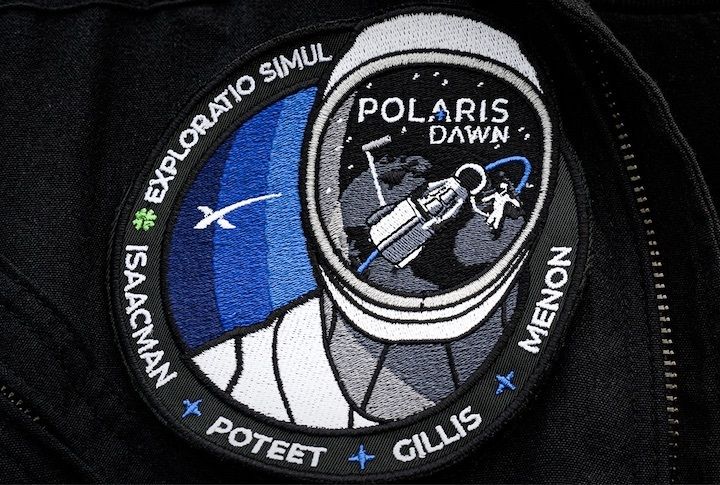
Different than NASA: Polaris Dawn spacesuits, spacewalk break new ground
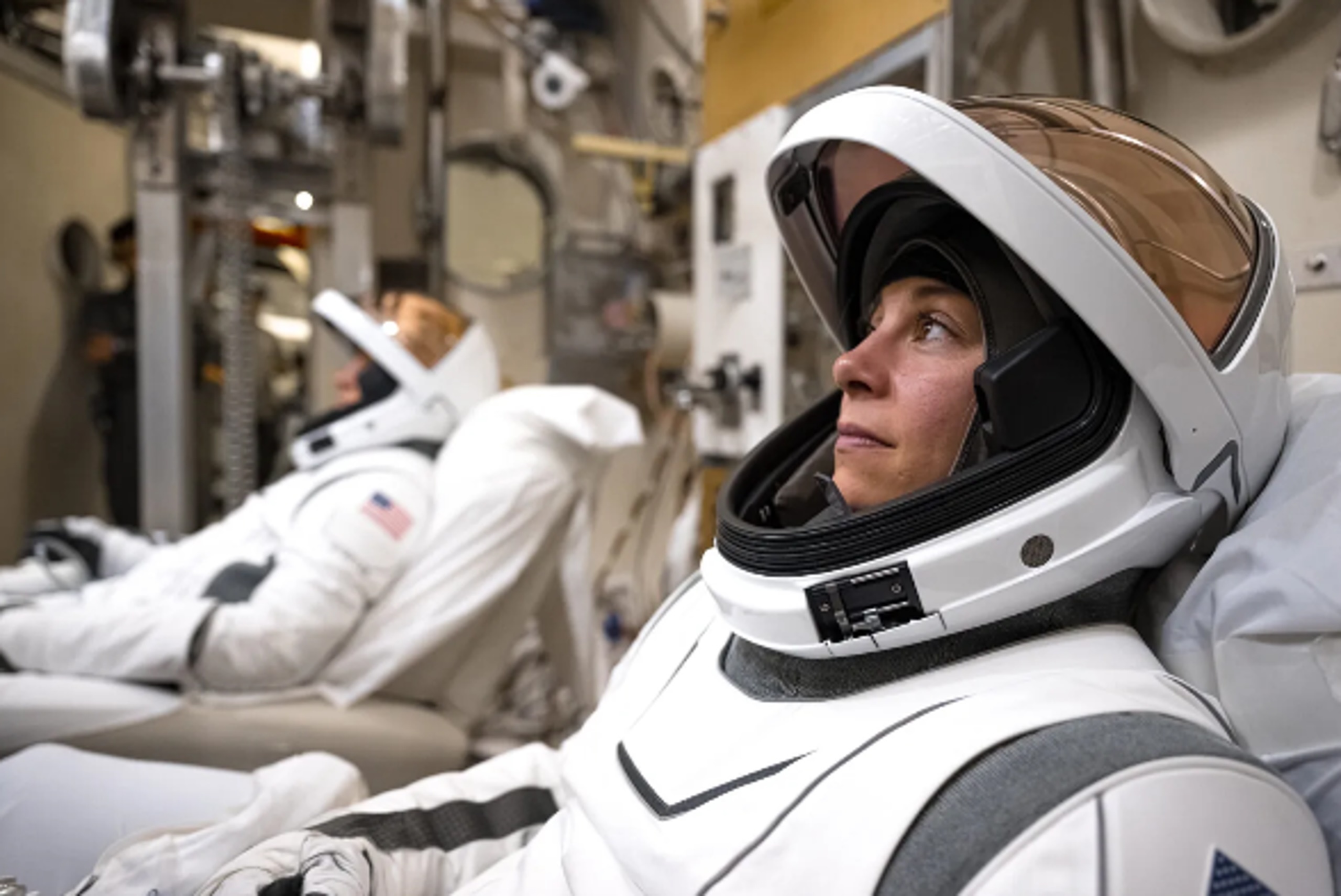
How do you solve space motion sickness — so astronauts aren’t "nauseous and potentially throwing up" the entire mission?
How do you test a new spacesuit to ensure it not only works in weightlessness, but also in the vacuum of space?
And, finally, what will launching into space feel like?
Those are some of the questions the crew of the upcoming Polaris Dawn mission have been focusing on as they prepare for their history-making civilian mission − slated to liftoff in a SpaceX Dragon atop a Falcon 9 rocket from Cape Canaveral early Tuesday.
FLORIDA TODAY interviewed two of the crew members of Polaris Dawn: Sarah Gillis, who is an astronaut trainer at SpaceX, and Anna Menon, who oversees crew operations and works in mission control at SpaceX.
They are joining billionaire and businessman, Jared Isaacman (who also commanded the first all civilian mission to orbit, Inspiration4) and former Air Force Lieutenant Colonel, Scott "Kidd" Poteet, who will serve as the Polaris Dawn pilot.
In a wide-ranging interview well before pre-launch quarantine, Gillis and Menon talked about the new SpaceX spacesuits that will be necessary for all four crew members to wear during Isaacman’s spacewalk, some of the other experiments the team will be conducting in space, how they expect to be feeling on launch day, and what treats they are bringing up to orbit.
How did SpaceX test the new spacesuits

Q: It's a first of it's kind, as the previous SpaceX suits were never designed to be used outside the spacecraft. What kind of training do you have as far as the new spacesuits?Gillis: What is so cool about this mission, though, is that we get to create a whole new training component because we've never had to train for a spacewalk before. So, we obviously started with our standard training program — which is what every NASA crew member goes through for living and flying in Dragon.
And then we took a look at what are the skills that we need to train to actually accomplish the spacewalk. There's everything from the physical movements inside the suit and understanding the environment you're in and how you move, operate, and function.
There's also the mental components of taking on this challenge as a team and how you work as a crew — and how you ensure you're really prepared. And we took a look at all sides of it.
The SpaceX team — they were in the process of building a brand new spacesuit to support this, and rather than go the traditional route of taking that suit and putting it in the water, which is the analog that NASA has used for a while for training spacewalks — we didn't have the luxury of having two suits, one that could go in water and one that could be used and dry air.
We were building the suits actively. So instead, they found this really awesome and innovative solution to basically take our suit, put it in a suspension harness, and then put specific physics models on a hoist. And in doing so, you can create a microgravity simulator — where you're able to fully pressurize the suit.
We've run, you know, pretty much every scenario the ground sim (simulation) supervisors can come up with to challenge us — all of the abort conditions, the termination criteria — so we feel that we really are prepared stepping into this.Q: When the Dragon hatch is opened, you will all be exposed to the vacuum of space. What testing has SpaceX done to ensure the suits function in that environment?
Menon: We absolutely know the suits can pressurize there. They have gone through so much extensive testing on the ground here at SpaceX — it’s really incredible with hardware.
We’ll be taking those suits and testing them in a vacuum chamber in Houston as the final acceptance test. We've spent a lot of time pressurizing the suits at this point.
What is SpaceX's goal for the new spacesuits
Q: How do you see the SpaceX spacesuits being a game changer in the space industry, especially with commercial space coming on board?Menon: You know, I think that this is a stepping stone for some of SpaceX’s long term ambitions but also, human spaceflight long term ambition. SpaceX envisions a world where human life is multiplanetary — and that we are one day putting people on the surface of Mars.

The human spaceflight efforts are starting to put people back on the surface of the moon. There are a lot of grand goals out there, and a lot of those efforts require spacesuits to do that. If you are going to go all the way to the moon or all the way to Mars, you're going to want to get outside your spacecraft and step foot on that other surface. And so you need a spacesuit to do that.
I think having additional capabilities out there — additional learning — we can all share that learning and learn from each other. It's only good for the future of human spaceflight.
What else is the Polaris Dawn mission focused on
Q: What experiments or objectives are you going to partake in during the mission?Menon: We have about 40 science and research experiments that we are doing as a part of this mission. And so basically, we have a few major mission objectives.
That's the high altitude flight, the first ever commercial spacewalk, and the testing of Starlink laser communication system for a Dragon human spacecraft.
But then, basically every moment in between those major mission objectives, we'll be doing science and research while we're up there. We are making it important to us that every minute is used to contribute to long term human spaceflight endeavors, and to the betterment of human life.
And so the science that we're tackling spans a lot of different areas, but a lot of it is really trying to help solve problems that we will need to solve in order to make life multiplanetary.
To give some examples, a handful of experiments tackle space motion sickness, which is an issue that plagues 60% of astronauts when they first hit microgravity. It renders them nauseous, potentially throwing up, pretty nonfunctional in many cases for about the first three days as they become accustomed to this new environment.
If you imagine a world where we're sending 100 people into space at the same time, you'd have 60 people floating around vomiting. That's not going to make for a very clean or productive spacecraft. So really, solving this, better understanding who gets this, and how to mitigate it, is going to be really important for our future spaceflight endeavors.
Another category of science research that we're doing deals with the vision problems that plague astronauts, when they're in microgravity for extended durations of time. There's a syndrome called Spaceflight Associated Neuro Ocular Syndrome.
There's already been some great research on this by NASA and others on the International Space Station. But there's still a lot to learn about. There's still a lot to be done to understand exactly the mechanisms causing it.
What is the Polaris Dawn mission timeline
Q: How long is the mission going to be?Gillis: Our mission timeline for our flight is five days. We have consumables for about 120 hours. There's also plenty of margin after that, but really, our expected timeline is about 120 hours. If weather degrades, and we need to come home early, we certainly can. But as Anna mentioned, we have a really, really full schedule so hopefully we'll be able to see that full time on orbit.
Polaris Dawn launch day
Q: What do you anticipate launch day? How is the launch day going to play out?Gillis: We would probably spend seven or 10 days at the Cape ahead of launch. We do have a week of training, and that's like a refresher of the pad systems and what to expect as we go through the day of launch.
We also will, you know, watch the static fire of our of our rocket, and get to see it as it rolls out to the pad.
So (there’s) some really cool pre-launch milestones that we'll go through.
By the time we're actually at day of launch, we've simulated the launch sequence so many times, hopefully there's no surprises, and it's kind of smooth and we have good weather.
I'm so interested to see what my emotions are going through that moment. I think it'll be a lot to process, and just wonderful to finally get to ride on this incredible rocket and spacecraft that the SpaceX team has built over so, so much time and tested for so long.
I will definitely be thinking of all of the engineers that performed the design, and the testing, and the validation of our system. So excited to get there.Menon: We've heard from people that they get into the spacecraft and it feels just like they're in the simulator —because they have rehearsed so many times.Gillis: That's what's super cool about the training — is that really does prepare you for the nominal and the off nominal, and exactly what you need to do in every situation.
What do you eat in space
Q: Fun question — Are there any treats that you plan to bring along?Menon: Well, the SpaceX team has solved food in a really creative way. They pack us about a days or so worth of fresh food. They pack it in a cooler, and the way they keep it cool and fresh is by freezing cold brew coffee. And so, as the coffee ice packs thaw, and we get to drink the coffee, and it keeps food wonderfully prepared for us. So things like pizza in space, sandwiches in space, vegetables in space, things like that are very, very appreciated.
And then we get more like the camping variety of food, which we also love and are great with — things like Clif Bars.
Q: Is there anything about the Polaris Dawn mission you would like to add?Menon: I think the Polaris Program and the Polaris Dawn endeavors are to be building blocks for the future of human space exploration and for our collective future. But it also really strives to make a difference for the here and now today, too.
We don't want to ignore the problems that we face here on Earth. And so one of the ways that we're doing that is by continuing to raise funds and awareness for St. Jude Children's Research Hospital. Our commander, Jared Isaacman, flew on a mission before ours - Inspiration 4 - and on that mission they raised over $250 million for St. Jude.
Quelle: Florida Today
----
Update: 26.08.2024
.
SpaceX completes static fire test of its Falcon 9 rocket in preparation for the Polaris Dawn astronaut mission
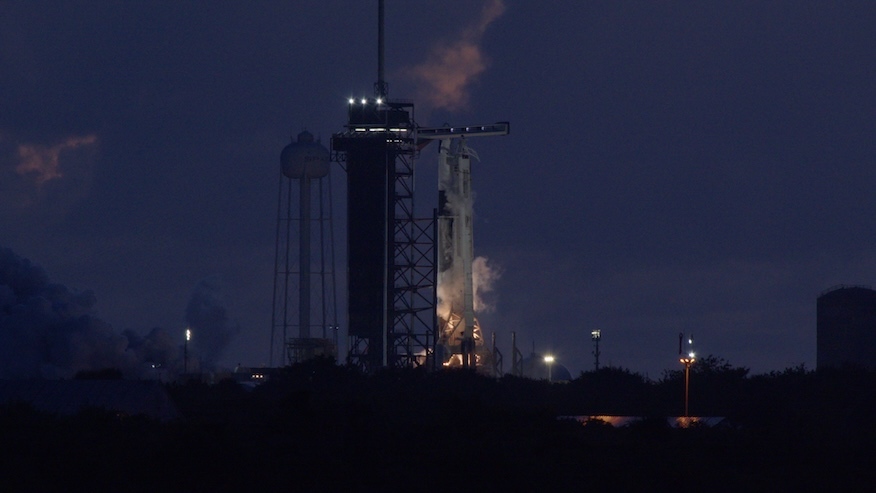
The SpaceX and Polaris Dawn teams checked a couple of important boxes before they are ready to launch the historic commercial mission.
A little less than a week after arriving at Florida’s Space Coast, the four astronauts stepped through all the activities they will experience on launch day, including suiting and and climbing aboard the Crew Dragon Resilience, which will be their home during the roughly five-day mission.
Following the activity known as a dry dress rehearsal, SpaceX cleared the pad at Launch Complex 39A in order to conduct a static fire test of its Falcon 9 rocket. The T-0 for ignition happened at 6:38 a.m. EDT (1038 UTC).
The engine firing lasted about 11 seconds in total. SpaceX engineers took the data gathered from the operation and will review it as they make their final prelaunch preparations.
The Falcon 9 first stage booster supporting this mission, B1083 in the SpaceX fleet, will make its fourth trip to space when it launches no earlier than Tuesday morning. It previously launched the Crew-8 mission aboard the Dragon Endeavour spacecraft in March, as well as two Starlink flights.
The SpaceX droneship that will be used to catch the booster following its pending launch, “A Shortfall of Gravitas,” set sail from Port Canaveral Saturday afternoon.
The Polaris Dawn mission will take the four crew members, Jared Isaacman, Scott “Kidd” Poteet, Sarah Gillis and Anna Menon, further than humans have gone since Apollo 17 in 1972 and witness the performance of the first commercial spacewalk.
It comes following more than two-and-a-half years of development work, testing and training across both SpaceX and NASA facilities.
“SpaceX and the teams and the crew, with their help, are continuing to push the envelope of what it takes to go to the Moon and Mars. We take the responsibility that we’ve been entrusted to us to fly the crew and return them safely home,” said William Gerstenmaier, the SpaceX vice president of Build and Flight Reliability, during a prelaunch briefing. “Spaceflight is not easy. Our mission right now is to safely launch Polaris, support their multi-day mission and return them home to their families and friends.”
This was SpaceX’s second launch pad static fire of the month, following a similar test on the first stage booster, B1085, which will be used to launch two people on the Crew-9 mission to the International Space Station. On Saturday, NASA determined that it will send just two people up to the orbiting outpost on this mission in order to preserve room for NASA astronauts Butch Wilmore and Suni Williams to return home.
Quelle: SN
+++
What time does SpaceX's Polaris Dawn private spacewalk mission launch?
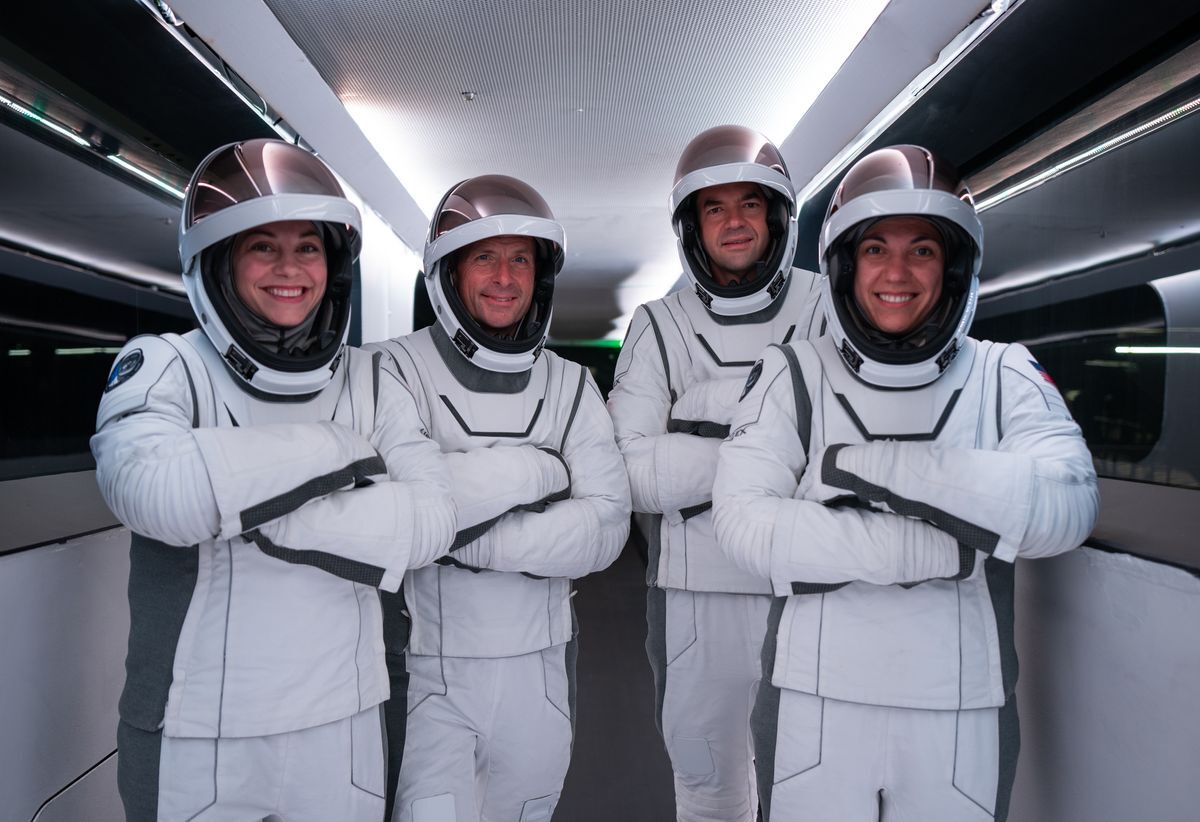
A SpaceX rocket will launch four people into space on the private Polaris Dawn mission this week and if you want to watch the liftoff live, you'll need to know when and where to watch. And in this case, it might help to be an early bird.
The Polaris Dawn mission, a commercial spaceflight backed by American billionaire Jared Isaacman that will attempt the first private spacewalk, is currently scheduled to launch on Tuesday, Aug. 27, on a Falcon 9 rocket and the Crew Dragon capsule Resilience. Liftoff is scheduled for 3:38 a.m. EDT (0738 GMT) from Florida's Cape Canaveral.
Here's a look at what time Polaris Dawn will fly, how to watch live online, who's on board and how long the mission will last.
SpaceX is currently targeting 3:38 a.m. EDT (0738 GMT) on Tuesday to launch the Polaris Dawn mission, but does have a four-hour window in which to fly. But that doesn't mean the launch could occur anytime between 3:38 a.m. EDT and 7:38 a.m. EDT (1138 GMT). Instead, SpaceX has now said it has two additional times during that window in which to launch. Those times are 5:23 a.m. EDT (0923 GMT) and 7:09 a.m. EDT (1109 GMT), the company wrote in a mission overview.
Polaris Dawn will liftoff from SpaceX's pad at Launch Complex 39A of NASA's Kennedy Space Center in Cape Canaveral, Florida. SpaceX has at least two opportunities to launch within the four-hour window, the company has said.
SpaceX rolled the Dragon spacecraft and its Falcon 9 rocket on the pad on Saturday (Aug. 24), and conducted a static fire of the Falcon 9's first-stage engines a day later. The Polaris Dawn crew, meanwhile, performed a dress rehearsal for launch day on Aug. 25.
SpaceX's Polaris Dawn mission will launch four private astronauts to space on a commercial flight financed by billionaire Jared Isaacman, who has already flown in orbit once with SpaceX in 2021's Inspiration4 mission. Here's a look at who's joining him on the mission. For a more in-depth look at the astronauts, check out our meet the Polaris Dawn crew story.
- Jared Isaacman: Isaacman is the financier of the Polaris Dawn and serves as the commander of the mission. The entrepreneur made his fortune as founder and CEO of Shift4Payments, a payment processing company. After Inspiration4, Isaacman purchased three more flights from SpaceX under his Polaris Program. Polaris Dawn is the first of those flights. He has logged over 6,000 hours flying high performance aircraft.
- Scott "Kidd" Poteet: Poteet is a retired U.S. Air Force Lieutenant Colonel and serves as the pilot of the Polaris Dawn mission. Polaris Dawn will be his first trip to space. He has logged over 3,200 hours flying jet aircraft and spent 20 years in the Air Force. He has previously served as director of business development at Draken International (a company Isaacman once owned, vice-president of strategy at Shift4 and was the mission director of Inspiration4.
- Sarah Gillis: Gillis is a mission specialist on Polaris Dawn and is SpaceX's lead space operations engineer in charge of astronaut training. She was the mission trainer for Isaacman's Inspiration4 flight. Gillis joined SpaceX as an intern in 2015 and studied aerospace engineering and dance at the University of Colorado, Boulder.
- Anna Menon: Menon is a mission specialist and chief medical officer of the Polaris Dawn crew. She is also SpaceX's lead operations engineer for crew operations development, and has served as a flight controller for the company's Demo-2 nd Crew-1 flights. Prior to joining SpaceX, Menon was a biomedical flight controller for the International Space Station, worked with Engineers Without Borders and is a private pilot. In addition to her Polaris Dawn duties, Menon also wrote a children's book "Kisses from Space" with Keri Vesak, which she will read from space. Proceeds from the book will help support St. Jude Children's Research Hospital.
Kisses from Space by Anna Menon, Keri Vesak, $19.99 now $15.99 at Amazon.
SpaceX lead operations engineer Anna Menon's Kisses From Space, published by Random House, will fly to space with Menon on the Polaris Dawn mission. Proceeds from the book will help support St. Jude Children's Research Hospital.
From liftoff to Falcon 9 booster landing, SpaceX's Polaris Dawn launch should last about 8.5 minutes, but the actual flight will last much longer.
Isaacman and his crew plan to spend at least five days in orbit during their private spacewalk. During that time, the crew will break the record for the highest spaceflight by female astronauts and also fly on the highest human spaceflight since the Apollo era.
Isaacman and the crew will also attempt the world's first private spacewalk on flight day 3, test a new orbital Starlink communications link on flight day 4 and conduct nearly 40 experiments while in orbit. A key experiment is the testing and demonstration of SpaceX's new spacesuits for spacewalking.
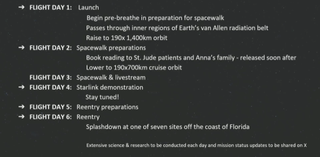
| Time (hr:min:sec) | Event | Header Cell - Column 2 |
|---|---|---|
| T-00:45:00 | SpaceX Launch Director 'Go' for Fueling | Row 0 - Cell 2 |
| T-00:42:00 | Crew Access Arm Retracts | Row 1 - Cell 2 |
| T-00:39:00 | Dragon Launch Escape System Armed | Row 2 - Cell 2 |
| T-00:35:00 | RP-1 propellant loading begins | Row 3 - Cell 2 |
| T-00:35:00 | 1st stage liquid oxygen (LOX) loading begins | Row 4 - Cell 2 |
| T-00:16:00 | 2nd stage LOX loading begins | Row 5 - Cell 2 |
| T-00:07:00 | Falcon 9 engine chilldown begins | Row 6 - Cell 2 |
| T-00:5:00 | Dragon on internal power | Row 7 - Cell 2 |
| T-00:01:00 | Flight computer prelaunch checks | Row 8 - Cell 2 |
| T-00:01:00 | Fuel tanks at flight pressure | Row 9 - Cell 2 |
| T-00:00:45 | Launch Director gives 'GO' for launch | Row 10 - Cell 2 |
| T-00:00:03 | Ignition Sequence Start | Row 11 - Cell 2 |
| T-00:00:00 | Falcon 9 Liftoff! | Row 12 - Cell 2 |
| T+00:00:58 | Max Q | Row 13 - Cell 2 |
| T+00:02:26 | 1st stage main engine cutoff | Row 14 - Cell 2 |
| T+00:02:29 | Stage Separation | Row 15 - Cell 2 |
| T+00:02:37 | 2nd stage engine start | Row 16 - Cell 2 |
| T+00:02:43 | 1st stage boostback burn starts | Row 17 - Cell 2 |
| T+00:03:30 | 1st stage boostback burn ends | Row 18 - Cell 2 |
| T+00:06:16 | 1st stage entry burn starts | Row 19 - Cell 2 |
| T+00:06:27 | 1st stage entry burn ends | Row 20 - Cell 2 |
| T+00:07:21 | 1st stage landing burn | Row 21 - Cell 2 |
| T+00:07:38 | 1st stage landing | Row 22 - Cell 2 |
| T+00:08:49 | 2nd stage engine cutoff | Row 23 - Cell 2 |
| T+00:11:55 | Dragon separation | Row 24 - Cell 2 |
| T+00:12:43 | Dragon nosecone opens | Row 25 - Cell 2 |
While SpaceX is targeting a 3:38 a.m. EDT launch on Aug. 27 for the Polaris Dawn crew, the company could delay or scrub the mission due to technical or weather issues. As such, the company has a backup launch opportunity, with liftoff scheduled for the same time of day.
If an issue prevents Polaris Dawn's launch on Aug. 27, SpaceX could try again on Aug. 28 at 3:38 a.m. EDT. As with the Aug. 27 attempt, SpaceX would have a four-hour window in which to launch the mission, with two chances to fly during that window, likely again at 5:23 a.m. EDT and 7:09 a.m. EDT.
In fact, SpaceX has already delayed the launch by one day. It was originally scheduled to launch on Monday, Aug. 26, with SpaceX postponing the flight by 24 hours to allow time for extra rocket checks.
Quelle: SC
----
Update: 27.08.2024
.
Polaris Dawn launch attempt delayed to early Wednesday morning, SpaceX reports
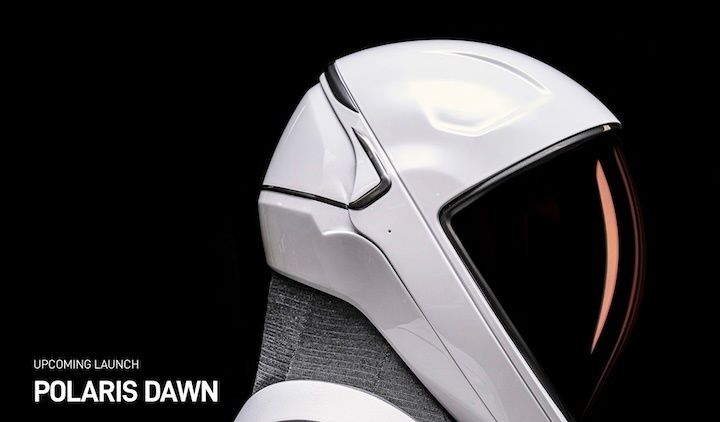
The first Polaris Dawn launch attempt has been postponed to early Wednesday morning. Why? Teams are taking a closer look at a groundside helium leak, SpaceX reported.
"We’re officially scrubbed for today, but the @SpaceX team is doing awesome work to ensure all systems are 100% ready for launch!" Sarah Gillis, a SpaceX lead space operations engineer and Polaris Dawn mission specialist, said in a Monday night tweet.
Now, SpaceX is targeting 3:38 a.m. EDT Wednesday to launch Polaris Dawn's Falcon 9 rocket from pad 39A at NASA's Kennedy Space Center. If delays arise, a pair of backup opportunities will be available a few hours later, at 5:23 a.m. and 7:09 a.m.
On Sunday, crews performed a static fire test of the Falcon 9 and crew members completed a full rehearsal of launch day activities. However, the Polaris Dawn launch attempt was called off Monday night more than seven hours ahead of liftoff.
"Teams are taking a closer look at a ground-side helium leak on the Quick Disconnect umbilical. Falcon and Dragon remain healthy and the crew continues to be ready for their multi-day mission to low-Earth orbit," SpaceX officials said in an 8:17 p.m. Monday tweet.
The four Polaris Dawn crew members will launch into orbit for their five-day mission — featuring a daring spacewalk outside their SpaceX Dragon capsule. No Central Florida sonic booms are expected. After soaring skyward along a northeasterly trajectory, the rocket's first-stage booster will target landing aboard the SpaceX drone ship A Shortfall of Gravitas in the Atlantic Ocean.
The Space Force's 45th Weather Squadron predicts 90% "go for launch" weather for Polaris Dawn on Wednesday.
Meanwhile — though SpaceX has yet to announce this mission — a Coast Guard-Space Launch Delta 45 rocket launch advisory showed the Starlink 8-6 mission would lift off early Wednesday morning from adjacent Cape Canaveral Space Force Station. That launch target is now in doubt in light of the Polaris Dawn rescheduling.
Quelle: Florida Today
----
Update: 5.09.2024
.
SpaceX targets Wednesday Starlink launch; Polaris Dawn launch target moves to Friday
As SpaceX targets Wednesday afternoon for its next Starlink launch from the Space Coast, a Federal Aviation Administration operations plan advisory shows the next Polaris Dawn liftoff try will occur Friday — the same day Boeing's malfunctioning Starliner is scheduled to undock from the International Space Station for return to Earth.
First up, Wednesday's Starlink 8-11 mission has been pushed back to a 12:07 p.m. EDT target liftoff time. Only one backup opportunity remains available if needed, at 12:59 p.m., SpaceX reported.
Then Friday, an FAA launch window for Polaris Dawn opens at 3:33 a.m. and extends through 7:38 a.m. The four Polaris Dawn crew members remain in quarantine at NASA's Kennedy Space Center awaiting liftoff on their ambitious five-day orbital mission. This privately funded mission with an all-civilian crew will launch aboard a Falcon 9 rocket from KSC pad 39A — with plans to embark on the world's first commercial spacewalk outside their SpaceX Dragon capsule.
Later Friday, about 6:04 p.m., Starliner will autonomously undock from the ISS — with no humans aboard — with plans to reenter Earth's atmosphere and land about 12:03 a.m. Saturday at White Sands Space Harbor in the New Mexican desert.
NASA astronauts Butch Wilmore and Suni Williams, who launched aboard Starliner on June 5, will now remain on the orbiting outpost until February. They'll return to Earth with two of the Crew-9 astronauts aboard a SpaceX Dragon capsule.
Polaris Dawn commander: 'Big launch day is getting closer'
A helium leak at the launch pad scrubbed the initial Polaris Dawn launch try on Aug. 27. Unfavorable Dragon splashdown weather forecasts have sidelined the mission since, as did a brief FAA investigation into the Aug. 28 fiery Falcon 9 booster mishap aboard a drone ship.
"Staying busy in quarantine with some formation flying, timeline review, staying fit and focused on the mission ahead. Grateful for the amazing team and this incredible opportunity. Big launch day is getting closer," mission commander Jared Isaacman said in a Sunday tweet featuring photos of the crew flying with the Polaris Ghost Squadron.
Quelle: Florida Today
